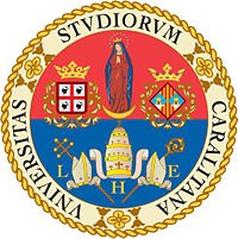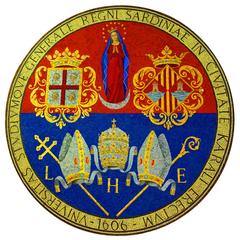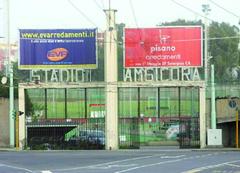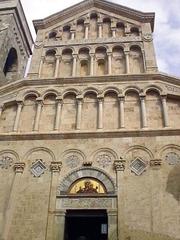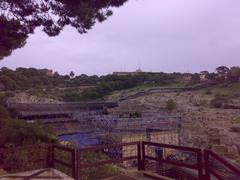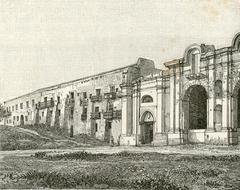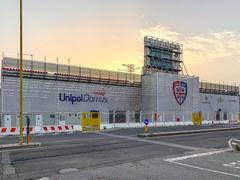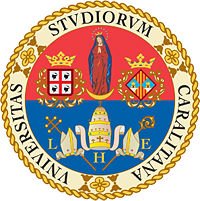
University of Cagliari: Visiting Hours, Tickets, and Historical Sites in Cagliari
Date: 14/06/2025
Introduction
The University of Cagliari, established in 1606 by King Philip III of Spain, is a cornerstone of both academic excellence and cultural heritage in Sardinia’s capital city. As one of Italy’s oldest universities, its presence in the historic Castello district and modern campuses provides visitors with a compelling blend of tradition, innovation, and vibrant city life. This guide offers detailed information on visiting hours, ticketing, accessibility, guided tours, and nearby attractions, ensuring you get the most from your exploration of this remarkable institution and its surrounding historical sites (University of Cagliari Official Site, Villassardinia.net, Strictly Sardinia).
Contents
- Historical Overview and Evolution
- Visiting the University: Practical Information
- Botanical Gardens: Nature Meets Science
- Campus Locations and Architectural Highlights
- Cultural Context and Local Life
- Accommodation and Dining
- FAQ
- Plan Your Visit: Tips and Resources
- Summary and Call to Action
- Sources
Historical Overview and Evolution
Founding and Early Development
Founded in 1606, the University of Cagliari began as a center for theology, law, medicine, and philosophy. Its early years were shaped by Spanish rule and the influence of religious orders, with its first buildings in the fortified Castello district (facts.net, villassardinia.net).
Enlightenment and Expansion
The 18th and 19th centuries brought modernization, with the addition of natural sciences and languages, and reforms following Italian unification (studyqa.com).
Modern Growth
After World War II, the university extended its reach, adding new faculties and developing the main Monserrato campus in the 1960s-70s, which today houses medicine, engineering, and the renowned Orto Botanico di Cagliari (en.unica.it).
Internationalization
Recent years have seen the introduction of English-taught programs—including medicine—attracting a diverse international student body (wauimat.com).
Visiting the University: Practical Information
Visiting Hours and Ticketing
- Historic Castello District: Open to the public, free to enter year-round.
- Orto Botanico di Cagliari: Open Tuesday–Sunday, 9:00 AM–6:00 PM. Tickets: €5 adults; discounts for students/seniors (villassardinia.net).
- Museo Archeologico Nazionale: Open daily except Mondays, 9:00 AM–7:00 PM. Tickets: €8; free for EU citizens under 18 and over 65.
Accessibility
Modern facilities, including the Monserrato campus and the botanical garden, are wheelchair accessible. Assistance is available upon request; contact the university ahead of your visit (UniCa Disability Office).
Guided Tours & Events
Guided tours of historic buildings and the botanical garden can be arranged in advance and are often available in English and Italian. The university regularly hosts public lectures and exhibitions; check the events calendar for updates.
Photography
Photography is welcome in public spaces, including the Castello district and botanical gardens. Permissions may be required inside offices or classrooms.
Travel Tips
- Transport: Use public transit or walk to sites in the city center to avoid parking issues.
- Timing: Spring and autumn offer the most pleasant weather.
- Combine Visits: Explore the Bastione di Saint Remy, Torre dell’Elefante, and Roman Amphitheatre, all nearby.
Botanical Gardens: Nature Meets Science
The Orto Botanico di Cagliari, established in 1866, is a living museum with Mediterranean and global flora, greenhouses, and orchard sections. It serves both as a research hub and a tranquil retreat, with rare and native Sardinian species on display (https://www.unica.it/en/botanical-gardens).
- Opening Hours: Tues–Sun, 9:00 AM–6:00 PM; closed Mondays.
- Admission: €5 adults, €3 students/seniors, free for children under 12 and university students/staff.
- Facilities: Wheelchair accessible; paved paths and ramps.
- Tours & Events: Weekends and group tours by arrangement, including workshops and exhibitions.
- Nearby: Close to the Roman Amphitheatre and Castello district.
Photography is encouraged for personal use; professional shoots require permission. Picnics are permitted in designated areas, and educational activities for children are available during school holidays.
Campus Locations and Architectural Highlights
Central Campus (Castello District)
- Main Building: Neoclassical architecture, home to the Rectorate and administrative offices.
- Nearby Landmarks: Cagliari Cathedral, Torre dell’Elefante, and panoramic viewpoints.
- Events: Monumenti Aperti (June) opens historic halls to the public (Hostelworld).
Monserrato Campus
- Location: 5 km from city center, accessible by MetroCagliari and bus.
- Facilities: Modern research centers, university hospital, and green spaces (Times Higher Education).
Specialized Sites
- Faculty of Engineering and Architecture: Merges historical and contemporary design (EAAE).
- Orto Botanico di Cagliari: 19th-century landscape, Mediterranean flora, classical sculptures (Trek Zone).
Cultural Context and Local Life
Academic and Social Influence
The university shapes the city’s intellectual and social life, attracting students from across Italy and beyond. Its proximity to archaeological sites and museums enriches the curriculum (archaeology-travel.com).
Language and Festivals
While Italian is the language of instruction, Sardinian dialects and traditions are celebrated in university events and city festivals, notably “Sa die de sa Sardigna” (April 28) and the Sant’Efisio festival in May (overyourplace.com).
Student Life and Gastronomy
Student energy is evident in local cafés and markets, particularly in the Stampace and Castello districts. Visitors can sample Sardinian dishes like malloreddus and seadas at the San Benedetto Market or nearby trattorias (nomads-travel-guide.com).
Accommodation and Dining
Where to Stay
- Castello District: Historic heart, close to campus (xixerone.com).
- Stampace: Lively, affordable, student-friendly (kevmrc.com).
- Marina: Convenient for transport and attractions (travellingking.com).
Recommended Accommodations
- Villa Fanny: Boutique hotel with a gourmet restaurant (strictlysardinia.com).
- Palazzo Dessy, Iola Rooms, Gioja Suite: Range from modern to budget-friendly (kevmrc.com).
Book early during festivals or university events, and check for accessibility if needed.
Dining Tips
University cafeterias offer affordable meals, while the surrounding neighborhoods feature local specialties like fregola con arselle and pane carasau (Savoring Italy).
Frequently Asked Questions (FAQ)
Q: What are the main visiting hours?
A: University buildings are generally open Monday–Friday, 9:00 AM–5:00 PM; museums and the botanical garden have specific hours.
Q: Is there an admission fee?
A: Most university sites are free; the Orto Botanico and museums require tickets.
Q: Are guided tours available?
A: Yes, often in multiple languages; book through the university or tourist offices (strictlysardinia.com).
Q: Is the university accessible for people with disabilities?
A: Many facilities are accessible; confirm in advance for historic buildings.
Q: How do I get from the airport?
A: Use Cagliari’s bus and tram network for efficient city and campus connections (xixerone.com).
Plan Your Visit: Tips and Resources
- Best Time to Visit: Spring and autumn for comfortable weather and festivals.
- Transport: Public buses and MetroCagliari are convenient; walking is ideal in the city center.
- Safety: Cagliari is safe; take standard precautions at night.
- Etiquette: Dress modestly for religious or academic settings; learn basic Italian phrases for a smoother experience.
- Local Customs: Afternoon siesta (“riposo”) is observed; shops may close midday.
- Nature and Recreation: Visit Poetto Beach and Molentargius-Saline Regional Park for relaxation and wildlife (nomads-travel-guide.com).
- Events: Monumenti Aperti in June offers special access to historic sites.
Summary
The University of Cagliari is a vibrant institution at the crossroads of Sardinia’s history, culture, and academic innovation. From its majestic neoclassical buildings in the Castello district to the lush Orto Botanico and dynamic student life, visitors are immersed in a multifaceted experience. With accessible facilities, guided tours, and proximity to other major historical attractions, the university stands out as a must-visit destination in Cagliari. Plan your visit to coincide with local festivals, utilize public transportation, and don’t miss the chance to savor authentic Sardinian cuisine and hospitality.
For the latest information, interactive maps, and exclusive tours, download the Audiala app and follow official university and tourism channels. Embark on a journey of discovery at the University of Cagliari—a historical and academic gem in the heart of Sardinia (University of Cagliari International Office, Sardegna Turismo, Audiala app).
Sources and Further Reading
- 32 Facts About Cagliari – facts.net
- A Guide to Cagliari – Villassardinia.net
- University of Cagliari Overview – StudyQA
- University of Cagliari Official Website
- University of Cagliari International Office
- Medicine in English Italy Seats – Wauimat.com
- Botanical Gardens – University of Cagliari
- University of Cagliari and Orto Botanico – Trek Zone
- Cagliari Travel Guide – Hostelworld
- Cagliari City Guide – Savoring Italy
- History of Cagliari – Archaeology Travel
- 3 Days in Cagliari Itinerary – Strictly Sardinia
- Cagliari Culture Guide – Overyourplace.com
- Where to Stay in Cagliari – Kevmrc.com
- Cagliari Itinerary and Accommodation – Travellingking.com
- University of Cagliari Ranking – Times Higher Education
- Cagliari Architecture Faculty – EAAE
- Sardegna Turismo Official Website
